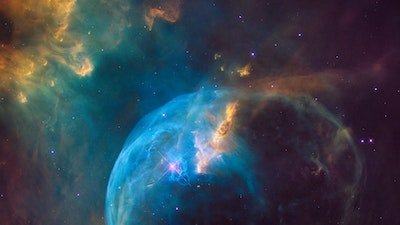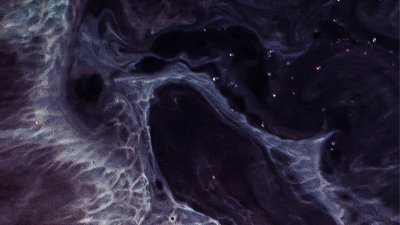
Recent Studies of Cosmological (Cosmic?) Importance
Recently there have been press accounts of two new studies related to cosmology. However, before I can discuss this new research, I need to provide some background information.
The Hubble Law
Edwin Hubble is credited with discovering the expansion of the universe in 1929. What Hubble found was a linear relationship between the redshifts and distances of galaxies. We call this relationship the Hubble law, or at least that’s what its official name is now. Until recently, most astronomers just called it the Hubble relation.
What is redshift? The light of a galaxy is the combined light of all its stars. The spectra of stars, and hence galaxies, have absorption features that appear as dark lines at certain wavelengths. We call the wavelength of a spectral line its rest wavelength. We know the rest wavelengths of spectral lines, so any deviation from the rest wavelength is easy to measure. It is an observational fact that the spectral lines of nearly all galaxies are shifted toward longer wavelengths. Since in the visible spectrum, longer wavelengths correspond with red color, we call this phenomenon in galaxies redshift. And Hubble discovered that galaxy redshift and distance are related—the greater the distance, the greater the redshift (the Hubble law).
Hubble discovered that galaxy redshift and distance are related—the greater the distance, the greater the redshift (the Hubble law).
Naturally, we can turn this around and use the amount of redshift to determine the distance of a galaxy, if we know the slope of Hubble Law, the so-called Hubble constant. That has been the rub in cosmology for nearly a century—what is the value of the Hubble constant, H0? It isn’t easy to determine H0. Over the years we’ve gotten better at measuring it, but there still is some uncertainty in what its exact value is.
And just what does the Hubble law mean? The most straightforward interpretation is that the universe is expanding. When objects move away from us, their spectra are shifted to longer wavelengths, producing a redshift. Likewise, objects moving toward us are blueshifted. The fact that most galaxies have redshift, and only a very few nearby galaxies have blueshifts, indicates that objects in the universe are flying away from us. I’m sorry—that’s a bit misleading. It isn’t that distant galaxies are moving away from us. Rather, it’s that the space between us and distant galaxies is expanding. Confused? Don’t worry—many people have difficulty with this concept. Keep in mind that universal expansion is the simplest, most straightforward interpretation of the Hubble law. Also, keep in mind that this is an interpretation—there could be other reasons for the Hubble law. For now, I think that expansion is the best explanation.
Measuring the Hubble Constant
Why is H0 so difficult to measure? Redshift is relatively easy to measure, but distance is not. Over the past century, astronomers have developed many techniques for measuring the distances to galaxies, but those methods work only to certain distances. There also is a problem properly understanding redshifts. Observed redshift is the sum of cosmic expansion and true motion of galaxies in space, presumably due to local gravity. Unfortunately, redshifts due to expansion for nearby galaxies is modest, and it can be swamped by the effects of local gravity. To avoid the effects of local gravity, it is best to measure the redshifts of galaxies that are very far away, but we don’t know the distances of faraway galaxies very well, if at all. So, the catch-22 is that nearby galaxies have good distance measurements, but poorly understood redshifts, while distant galaxies have well-known redshifts, but not very precise measurements of distances.
Astronomers have always searched for bright standard candles—objects with known great brightness that can be seen at great distances. By comparing the measured brightness of a standard candle to its intrinsic brightness, we can find its distance. Its redshift then allows astronomers to find and determine H0. In practice, it is best to do this for many standard candles and average the result.
A few decades ago, astronomers began to utilize type Ia supernovae as a standard candle. A supernova is a large explosion in a star that causes the star to suddenly brighten tremendously before slowly fading. Observationally, we can distinguish between several types of supernovae. There are reasons to believe that type Ia supernovae have about the same intrinsic brightness at the peak of their outbursts. Hence, when a type Ia supernova occurs in a galaxy, we can determine that galaxy’s distance, and we also can measure the redshift of the host galaxy, resulting in a measure of H0. As before, it is best to use a sample size and form a sort of average.
The trend that they found was the opposite of what was expected.
This is what two teams of astronomers did two decades ago. One team was led by Saul Perlmutter, while the other team was led by Brian Schmidt and Adam Riess. Working independently of one another, the two teams reached the same conclusion: at great redshift, there is a systematic divergence from a linear relationship. This indicated that at very great distances, galaxies didn’t have the same redshift that they would have if the expansion of the universe were constant. A divergence at great redshift was expected. After all, the gravity of the matter in the universe would tend to slow down expansion with time. In fact, this is what both teams were looking for so that they could use this as a probe to determine the amount of matter in the universe. But the trend that they found was the opposite of what was expected. That is, expansion wasn’t slowing; it was speeding up. Either team thought that they had made a mistake. It wasn’t until they heard of each other’s results that they had confidence that they were on the right track.
The Cosmological Constant Versus Dark Energy
But what does it mean for the expansion of the universe to speed up? A century ago, Albert Einstein published his important paper on general relativity, a new theory of gravity, space, and time. When Einstein applied his new theory to the universe, it predicted that the universe was either expanding or contracting. Einstein didn’t think that this correctly reflected the universe, so he introduced his famous cosmological constant, Λ, to solve the problem. What is Λ? It represents a repulsive force that space has for itself. Einstein adjusted the value of Λ so that the repulsion exactly balanced the inward contraction of the universe due to the gravity of matter in the universe. This yielded a universe that was neither expanding nor contracting, which is what we call a static universe.
Other scientists soon saw that this overlooked the general solution for the universe, a universe that is either expanding or contracting. According to the math, the universe could do either, but the math couldn’t tell which one was the case. It is a matter of observation to determine which is true. This is a common thing in physics, to have two equally valid solutions for a physical solution, but only one describing reality. Some data that suggested that the universe is expanding already existed, but apparently this was unknown to Einstein. Others were aware of this data as well as the prediction of general relativity in the most general case. However, it was Edwin Hubble who had both knowledge of the prediction of general relativity and the data, as well as access to the largest telescopes in the world to definitively determine which solution was correct.
In the wake of Hubble’s discovery, Einstein reportedly referred to the introduction of Λ as his greatest blunder. However, this is too harsh. This “fudge factor,” as some came to call Λ, wasn’t a fudge factor at all. Rather, Λ is a constant of integration that always exists in the solutions of differential equations. Sometimes the constant of integration is zero (as most people came to think Λ must be), but the value of a constant of integration is properly determined by what are called the boundary conditions of the problem being solved. Einstein assumed that the universe was static, so naturally that was the boundary condition that he chose. As late as the 1950s, cosmologists were selecting values of Λ to support their ideas. For instance, for a time it appeared that the expansion of the universe was too fast to allow for a universe as old as what they thought the age of the earth was. This clearly wouldn’t do, so some ancient universe cosmologists imposed a value of Λ suitable to solve this problem. However, rather than assume a value of Λ, one ought to observe what the boundary conditions are, and select the value of Λ accordingly. At any rate, beginning in the 1950s, for nearly a half century most everyone had assumed that Λ was zero.
That is why the results of the two teams was such a shock two decades ago. For the first time, there was data that indicated a nonzero value for Λ. This was deemed so significant that Perlmutter, Schmidt, and Riess shared the Nobel Prize in Physics in 2011. Most cosmologists find this case for Λ so compelling that it has been folded into the standard model of cosmogony, the big bang. The model now is frequently called the ΛCDM model, where Λ refers to the assumption of a cosmological constant, and CDM refers to cold dark matter (as opposed to hot dark matter, perhaps a topic for a future article).
As the universe expands, the amount of repulsion may increase so that the universe expands ever more quickly.
I ought to clarify that the contemporary view of Λ is a bit different from Einstein’s cosmological constant. As before, in the current view, this physically amounts to a self-repulsion that space has. However, unlike before, cosmologists today allow that this repulsion may be time-varying. That is, instead of repelling at the same rate, the amount of repulsion might change over time. More specifically, as the universe expands, the amount of repulsion may increase so that the universe expands ever more quickly. To distinguish the new view of Λ, instead of calling Λ the cosmological constant, it now is referred to as “dark energy.” This choice of a name is unfortunate because the term implies that Λ is related to dark matter when it is not. The “energy” part comes from how Λ is viewed as deriving from a field that permeates the universe. Physicists often describe forces in terms of fields. Fields in turn describe a form of potential energy.
What Is New
With all these preliminary things out of the way, I’m now prepared to briefly discuss the two news items. Both papers propose new standard candles that apply to quasars. Quasars are extremely high redshift objects. Given their large redshifts, quasars likely are extremely far away and hence are the most luminous objects in the universe. Quasars frequently appear along the same line of sight as much closer galaxies. When this happens, the gravity of a galaxy can act as a lens to produce more than one image of the much more distant quasar. One paper used information about the mass distribution within the lensing galaxy to measure the distance to the lensed quasar, SDSS 1206+4332.1 Since this quasar’s redshift is much greater than any type Ia supernova yet observed, this extends the Hubble law to much greater redshift than before. When this quasar’s redshift is compared to its new distance measurement, a new value of H0 followed. That value is significantly less than the value of H0 determined by other means, indicating an even larger departure from Hubble’s law than found two decades ago using type Ia supernovae.
The other paper pioneered a new method of determining quasar distances in the general case (not just quasars that are lensed by nearer galaxies).2 This method compared the X-ray and ultraviolet emissions of quasars in a way that produces distances of the quasars. The preliminary results are consistent with the other study, that at great redshift the value of H0 is much less than indicated by studies at lower redshift. The most direct implication is that not only is dark energy real, but it is, as suspected, time varying.
What Does this Mean to Creationists?
If you haven’t suspected it yet, much of this discussion relies upon assumption of great age and the big bang model. We believe that Scripture doesn’t allow for either. Therefore, we are not constrained to look at this new data in the same way. So, how might biblical creationists view these new studies? That is not clear. Cosmologists generally assume that for extragalactic objects, redshifts are cosmological. That is, redshifts are the result of cosmic expansion and hence reflect distance. But remember that expansion is an interpretation of the Hubble law. Could there be other interpretations? Yes, but there has been no plausible alternative yet.
If the universe is finite in size with an edge as some creationists suggest, then the cosmological principle cannot be true.
Furthermore, the standard cosmology is based upon what is called the cosmological principle. The cosmological principle is the assumption that the universe is both homogeneous (appearing the same everywhere) and isotropic (appearing the same in every direction). But is the cosmological principle true? If the universe is finite in size with an edge as some creationists suggest, then the cosmological principle cannot be true, because an observer near the edge of the universe would not see the universe the same as someone located far from the edge. This realization has great implications. It calls into question whether redshifts are due to expansion. Furthermore, it may undermine the assumption that the Hubble law works for all extragalactic objects. That is the thinking of some biblical creationists.
Since the two recent studies discussed above are interpreted through an evolutionary model of cosmology, what is the creationary model of cosmology? Alas, there is no agreed-upon cosmology among biblical creationists. Without a consensus or even a single good model, it is difficult to say what the implication of the Hubble law is, or what the change in the slope of the Hubble law at great redshift means. Perhaps in time, I can offer a better answer to that question.
Footnotes
- Mara Johnson-Groh, “Something Is Not Quite Right In the Universe, Ultraprecise New Measurement Reveals,” LiveScience, February 8, 2019, https://www.livescience.com/64724-hubble-constant-measured-precisely-with-quasars.html.
- Mike Wall, “Dark Energy Gets Weirder: Mysterious Force May Vary over Time,” Fox News, February 1, 2019, https://www.foxnews.com/science/dark-energy-gets-weirder-mysterious-force-may-vary-over-time.
Recommended Resources

Answers in Genesis is an apologetics ministry, dedicated to helping Christians defend their faith and proclaim the good news of Jesus Christ.
- Customer Service 800.778.3390
- Available Monday–Friday | 9 AM–5 PM ET
- © 2026 Answers in Genesis




